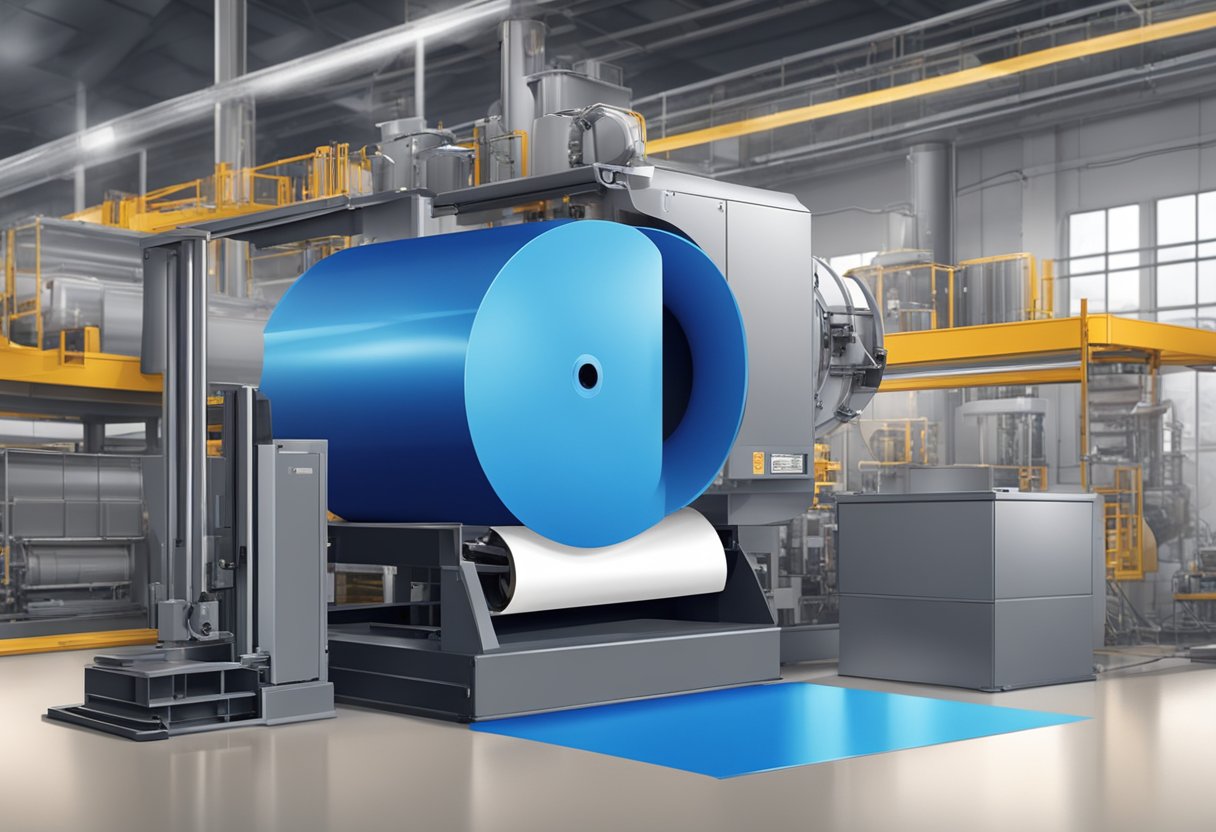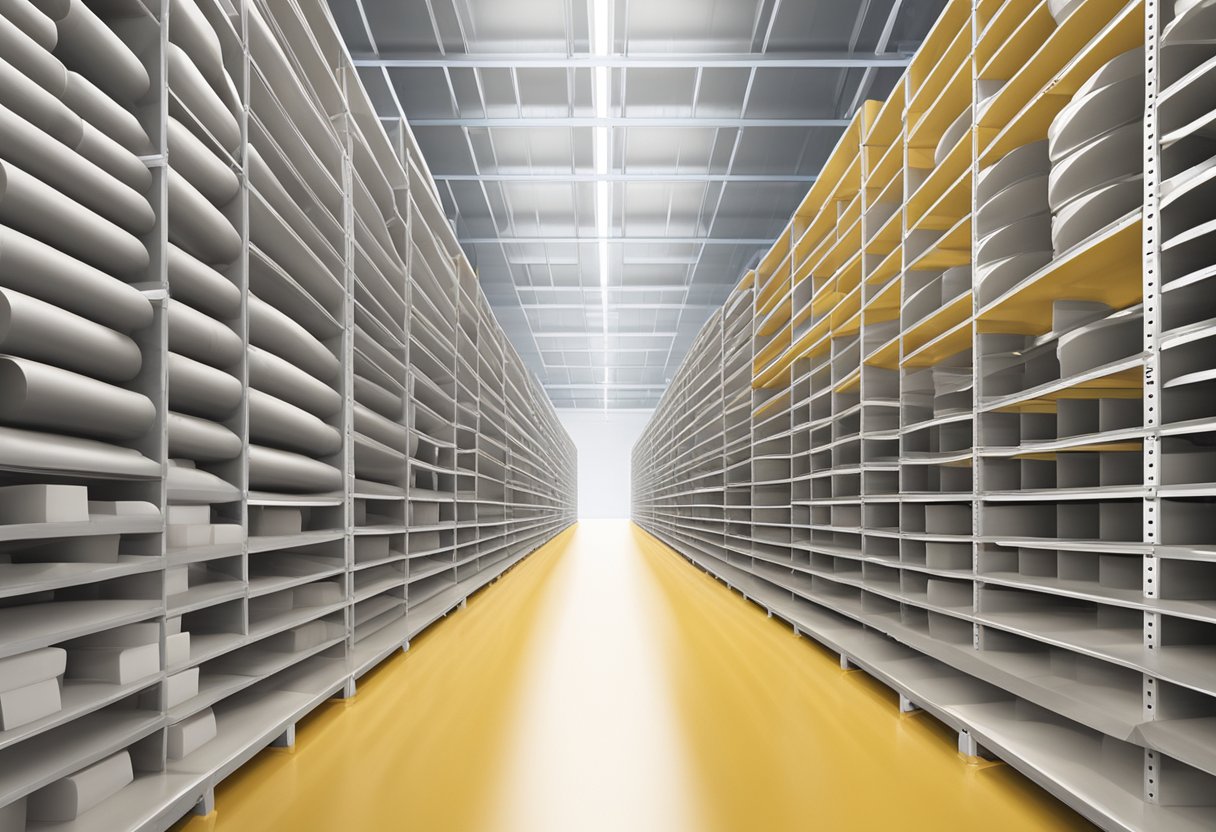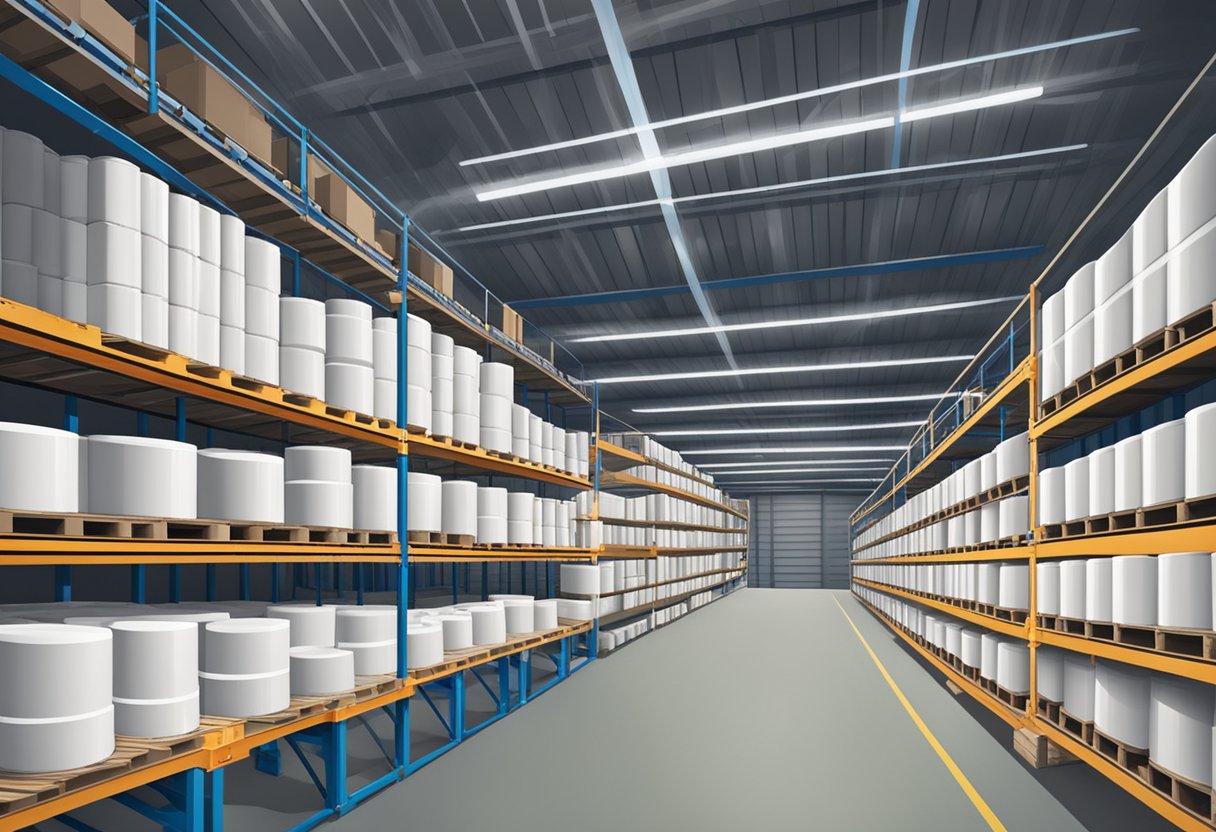Stretch Film Jumbo Roll: The Benefits of Buying in Bulk
Stretch film jumbo roll is a type of packaging material that is widely used in various industries. It is a large roll of stretch film that is designed to be used with a dispenser to wrap and secure products for transportation and storage. The stretch film is made from high-quality materials that provide strength, durability, and flexibility.

The use of stretch film jumbo roll has become increasingly popular due to its many benefits. It is an efficient and cost-effective way to protect products during shipping and storage. The stretch film conforms to the shape of the product, providing a tight and secure wrap that prevents damage from moisture, dust, and other contaminants. Additionally, the stretch film is easy to apply and remove, making it a preferred choice for many businesses.
Overview of Stretch Film Jumbo Rolls

Stretch film jumbo rolls are large rolls of stretch film that are used in various industries for packaging and shipping purposes. They are typically made of polyethylene, a strong and durable plastic material that can withstand the rigors of transportation and storage.
The jumbo rolls are available in different widths and thicknesses, depending on the specific application and requirements. The thickness of the film is measured in microns, with higher microns indicating a thicker and stronger film.
One of the main advantages of using stretch film jumbo rolls is their versatility. They can be used to wrap a wide range of products, from small items to large pallets. The film is also highly stretchable, allowing it to conform to the shape of the product and provide a secure and tight wrap.
Another benefit of stretch film jumbo rolls is their cost-effectiveness. They are more economical than pre-stretched films or other packaging materials, as they can be cut to the desired length and width, reducing waste and saving money.
Overall, stretch film jumbo rolls are a reliable and efficient solution for packaging and shipping needs in various industries.
Manufacturing Process

Raw Materials
The production of stretch film jumbo roll starts with the selection of high-quality raw materials. The most commonly used materials are linear low-density polyethylene (LLDPE) and metallocene polyethylene (mPE). These materials are chosen for their superior strength, flexibility, and puncture resistance.
Extrusion
The next step in the manufacturing process is extrusion. In this process, the raw materials are melted and then extruded through a die. The extruded film is then cooled and stretched to improve its strength and durability. This stretching process also helps to reduce the thickness of the film while maintaining its strength.
Slitting
After the extrusion process, the film is wound into large rolls known as jumbo rolls. These jumbo rolls are then sent to a slitting machine, where they are cut into smaller rolls of the desired width. The slitting process is critical as it determines the final width of the stretch film and ensures that it meets the customer’s specifications.
Overall, the manufacturing process of stretch film jumbo roll is a complex and precise process that requires expertise and attention to detail. The use of high-quality raw materials, advanced extrusion technology, and precise slitting techniques ensures that the final product is strong, durable, and of the highest quality.
Types of Stretch Film Jumbo Rolls

Hand Stretch Film
Hand stretch film jumbo rolls are designed for manual application. They are lightweight and easy to handle, making them ideal for small-scale packaging operations. Hand stretch film jumbo rolls are commonly used to wrap pallets, boxes, and other items for transport or storage. They are available in a variety of widths and thicknesses to meet different packaging needs.
Machine Stretch Film
Machine stretch film jumbo rolls are designed for use with stretch wrapping machines. They are typically heavier and thicker than hand stretch film jumbo rolls, and are engineered to withstand the rigors of high-speed machine application. Machine stretch film jumbo rolls offer excellent load stability and protection, making them ideal for large-scale packaging operations.
Pre-Stretched Film
Pre-stretched film jumbo rolls are designed to offer maximum yield and cost savings. They are pre-stretched during the manufacturing process, which means less film is needed to achieve the same level of load stability and protection. Pre-stretched film jumbo rolls are ideal for high-volume packaging operations, as they can help reduce material costs and increase efficiency.
Applications and Uses
Packaging Industry
Stretch film jumbo roll is widely used in the packaging industry for wrapping and securing products during transportation and storage. The film’s ability to stretch and cling tightly to the product provides excellent protection against damage caused by dust, moisture, and other external factors. It is commonly used for packaging products such as furniture, electronics, and appliances.
The film is available in various thicknesses and widths, making it suitable for different types of products. It can be easily applied using stretch wrapping machines, which ensure that the film is evenly distributed and tightly wrapped around the product.
Transportation and Logistics
Stretch film jumbo roll is an essential component of the transportation and logistics industry. It is used for pallet wrapping and securing goods during transportation. The film’s ability to stretch and cling to the product ensures that the load remains stable and secure during transit, reducing the risk of damage and loss.
The film is available in different grades, making it suitable for different types of transportation, including air, sea, and land. It is also available in various colors, allowing for easy identification of products during transportation.
Food and Beverage
Stretch film jumbo roll is also used in the food and beverage industry for packaging and preserving food products. The film’s ability to stretch and cling tightly to the product ensures that the food remains fresh and free from contamination.
The film is available in food-grade quality, making it suitable for direct contact with food products. It can be easily applied using manual or automatic wrapping machines, ensuring that the food is securely wrapped and protected during transportation and storage.
In conclusion, stretch film jumbo roll is a versatile packaging material that offers excellent protection and security to products during transportation and storage. Its ability to stretch and cling tightly to the product makes it an essential component of various industries, including packaging, transportation, and food and beverage.
Physical Properties
Thickness
Stretch film jumbo rolls have a thickness ranging from 12 to 50 microns. The thickness of the film determines its strength and durability. A thicker film is more resistant to punctures, tears, and other damages. The thickness of the film also determines its clinginess, which is important in securing and protecting items during transportation or storage.
Width
Stretch film jumbo rolls come in different widths ranging from 450mm to 2000mm. The width of the film determines the amount of coverage it provides. A wider film is more efficient in wrapping larger items and pallets. The width of the film also affects its stretchability, which is important in ensuring the film conforms to the shape of the item being wrapped.
Tensile Strength
The tensile strength of stretch film jumbo rolls refers to the amount of force required to break the film. It is measured in pounds per square inch (PSI) or newtons per square meter (N/m²). The tensile strength of the film determines its ability to withstand stress and strain during transportation or storage. A higher tensile strength film is more resistant to punctures, tears, and other damages.
Overall, the physical properties of stretch film jumbo rolls play a crucial role in their effectiveness in securing and protecting items during transportation or storage. The thickness, width, and tensile strength of the film should be carefully considered when selecting the appropriate film for a specific application.
Advantages of Jumbo Rolls
Cost-Effectiveness
Stretch film jumbo rolls offer cost-effectiveness in several ways. Firstly, they are available in larger sizes, which means that they can cover more products with less material. This results in a lower cost per unit of product wrapped. Secondly, purchasing jumbo rolls means that the cost of packaging material is reduced as compared to buying smaller rolls. This is because the cost of packaging material increases with the size of the roll. Lastly, buying jumbo rolls in bulk can result in significant cost savings due to economies of scale.
Reduced Waste
Stretch film jumbo rolls can help reduce waste in the packaging process. This is because they are available in larger sizes, which means that fewer rolls are needed to wrap a given number of products. This results in less packaging material waste. Moreover, jumbo rolls have a longer length, which means that they need to be changed less frequently. This reduces the amount of time and effort required to change rolls, leading to increased productivity.
Efficiency in Application
Stretch film jumbo rolls offer efficiency in the packaging process. This is because they can be applied using automatic stretch wrapping machines, which are faster and more efficient than manual application. Moreover, jumbo rolls are available in different thicknesses and strengths, which means that they can be tailored to the specific needs of the product being wrapped. This ensures that the product is securely wrapped, reducing the risk of damage during transportation.
In summary, stretch film jumbo rolls offer several advantages, including cost-effectiveness, reduced waste, and efficiency in application. These benefits make them a popular choice for businesses looking to improve their packaging process.
Storage and Handling
Storage Conditions
Stretch film jumbo rolls are typically stored in a dry and cool environment to prevent moisture and heat from affecting the quality of the film. It is recommended to store the jumbo rolls in a clean and dust-free area to avoid contamination. The rolls should be stored on pallets or shelves to prevent damage or deformation of the film.
When storing stretch film jumbo rolls, it is important to keep them away from direct sunlight and heat sources. Exposure to high temperatures can cause the film to become brittle and lose its elasticity, which can lead to tearing and breakage during use. Additionally, storing the rolls in a humid environment can cause the film to stick together, making it difficult to unroll and use.
Safety Precautions
When handling stretch film jumbo rolls, it is important to take proper safety precautions to avoid injury. The rolls can be heavy and awkward to handle, so it is recommended to use lifting equipment such as forklifts or pallet jacks to move them.
It is also important to wear appropriate personal protective equipment such as gloves and safety glasses when handling the film. The edges of the rolls can be sharp and can cause cuts or puncture wounds if not handled carefully.
In addition, it is important to follow proper handling procedures when using stretch film jumbo rolls. Improper use can result in damage to the film or injury to the user. It is recommended to read and follow the manufacturer’s instructions for use to ensure proper handling and optimal performance of the film.
Environmental Impact
Recyclability
Stretch film jumbo roll is a widely used packaging material that is known for its durability and versatility. However, its impact on the environment has been a topic of concern in recent years. One of the main issues with stretch film is that it is often not recyclable.
Most stretch film is made from polyethylene, which is a type of plastic that can be recycled. However, the recycling process can be difficult and expensive, and many recycling facilities are not equipped to handle stretch film. As a result, much of the stretch film used in packaging ends up in landfills or incinerators.
To address this issue, some manufacturers are developing new types of stretch film that are easier to recycle. These films are designed to be compatible with existing recycling systems, which makes them more environmentally friendly. Additionally, some companies are implementing take-back programs to collect used stretch film from customers and recycle it themselves.
Biodegradable Options
Another solution to the environmental impact of stretch film is to use biodegradable options. Biodegradable stretch film is made from materials that can break down naturally over time, reducing the amount of waste in landfills.
One popular material for biodegradable stretch film is polylactic acid (PLA), which is made from cornstarch. PLA is biodegradable and compostable, which means it can be broken down into organic matter that can be used as fertilizer.
However, it is important to note that biodegradable stretch film may not be the best option for all applications. Biodegradable films may not have the same strength and durability as traditional stretch film, which could lead to packaging failures and product damage. Additionally, biodegradable films may require special handling and disposal, which could add to the overall cost of packaging.
Overall, there are several options available for reducing the environmental impact of stretch film. By choosing recyclable or biodegradable options, businesses can help reduce the amount of waste generated by their packaging.
Market Trends
Demand Dynamics
Stretch film jumbo rolls are in high demand due to their versatility and cost-effectiveness. The demand for stretch film jumbo rolls is expected to increase in the coming years due to the growth of the packaging industry. The packaging industry is one of the major end-users of stretch film jumbo rolls, as they are used for packaging various products such as food, beverages, and pharmaceuticals.
The demand for stretch film jumbo rolls is also driven by the increasing demand for e-commerce packaging. With the rise of e-commerce, the demand for stretch film jumbo rolls has increased as they are used for packaging and protecting products during transportation. The demand for stretch film jumbo rolls is expected to increase as the e-commerce industry continues to grow.
Innovations
Innovations in stretch film jumbo rolls have led to the development of new products that offer better performance and cost-effectiveness. One of the recent innovations in stretch film jumbo rolls is the development of biodegradable stretch film jumbo rolls. These jumbo rolls are eco-friendly and can be easily disposed of without harming the environment.
Another innovation in stretch film jumbo rolls is the development of stretch films with improved puncture resistance. These films are designed to withstand sharp edges and rough handling during transportation, reducing the risk of damage to the packaged products.
Overall, the market trends for stretch film jumbo rolls are positive, with increasing demand and continuous innovations. As the packaging industry continues to grow, the demand for stretch film jumbo rolls is expected to increase, and manufacturers are expected to continue developing new products to meet the evolving needs of the market.
Regulatory Compliance
Quality Standards
Stretch film jumbo roll is subject to various quality standards to ensure that it meets the requirements of the end-users. One of the most important quality standards is the ISO 9001:2015 certification, which ensures that the manufacturer has a quality management system in place to consistently meet customer requirements. Other quality standards include the ASTM D4635-18 and the European Standard EN 13193:2008.
International Regulations
Stretch film jumbo roll is subject to various international regulations, depending on the country of origin and the destination country. For example, in the United States, stretch film jumbo roll is subject to regulations by the FDA, which ensures that the film is safe for use in food packaging. In Europe, stretch film jumbo roll is subject to the REACH regulation, which ensures that the film does not contain any harmful chemicals.
Manufacturers of stretch film jumbo roll must ensure that their products comply with all relevant regulations and standards to ensure that the end-users are not exposed to any health or safety risks. It is important for customers to verify that the stretch film jumbo roll they are purchasing meets all relevant regulations and standards to ensure that they are using a safe and reliable product.
Future Outlook
The demand for stretch film jumbo roll is expected to continue to grow in the coming years. The rise in e-commerce and online shopping has led to an increase in demand for stretch film jumbo roll for packaging and shipping purposes. The growth of the food and beverage industry is also expected to contribute to the demand for stretch film jumbo roll as it is commonly used for wrapping and protecting food items during transportation.
Manufacturers are expected to focus on developing more sustainable and eco-friendly stretch film jumbo roll options to meet the growing demand for environmentally friendly packaging solutions. This shift towards sustainability is also driven by the increasing awareness among consumers about the impact of packaging on the environment.
In addition, technological advancements in the production of stretch film jumbo roll are expected to improve the quality and performance of the product. This includes the development of stretch film jumbo roll with higher tensile strength, better tear resistance, and improved cling properties.
Overall, the future outlook for the stretch film jumbo roll market looks positive, with continued growth expected in the coming years. Manufacturers will need to adapt to changing consumer preferences and focus on innovation to remain competitive in the market.
